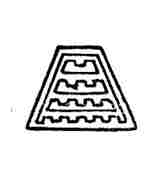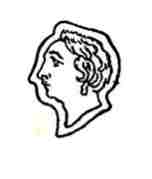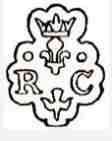A SMALL COLLECTION OF ANTIQUE SILVER |
| an article of Christophe Ginter, for ASCAS - Association of Small Collectors of Antique Silver |

|
(click on photos to enlarge image)SILVER HALLMARKS OF PARIS
|
| PARIS HALLMARKING SYSTEM |
Silver items were stamped with four marks
Two stamps were used for tax issues:
CHARGE MARK: was struck at the early beginning of the
sketch. This mark meant that the piece had been declared to the
tax authorities. Hence, this mark should be found side by side
with the maker's mark. Its size was large, similar to the
maker's mark.
DISCHARGE MARK: was struck when tax was paid. Its size
was roughly half as large as that of the Charge mark.
| CHARGE AND DISCHARGE MARKS |
| FEBRUARY 1722 - NOVEMBER 1726 |
| DECEMBER 1726 - OCTOBER 1732 |
| OCTOBER 1732 - SEPTEMBER 1738 |
 |
 |
 |
 |
charge mark:
|
charge mark:
|
discharge mark:
|
discharge mark:
|
From October 1738 the system based on large/small silver and golden objects marks maintained the same principles until the 1789 Revolution
| CHARGE MARKS | DISCHARGE MARKS |
| LARGE ITEMS | SMALL ITEMS AND GOLD | LARGE ITEMS | SMALL ITEMS AND GOLD |
| OCTOBER 1738 - SEPTEMBER 1744 |
 |
 |
 |
 |
| OCTOBER 1744 - SEPTEMBER 1750 |
 |
 |
 |
 |
| OCTOBER 1750 - SEPTEMBER 1756 |
 |
 |
 |
 |
| OCTOBER 1756 - SEPTEMBER 1762 |
 |
 |
 |
 |
| OCTOBER 1762 - SEPTEMBER 1768 |
 |
 |
 |
 |
| OCTOBER 1768 - NOVEMBER 1774 |
 |
 |
 |
 |
| LARGE ITEMS | SMALL ITEMS AND GOLD | LARGE ITEMS | SMALL ITEMS AND GOLD |
| YEARLY WARRANTY MARKS ("JURANDES") |
| F |
August 1722 August 1723 |
T |
September 1735 October 1736 |
I |
July 1749 July 1750 |
Y |
July 1762 July 1763 |
| G |
August 1723 August 1724 |
V |
October 1736 September 1737 |
K |
July 1750 January 1752 |
Z |
July 1763 July 1764 |
| H |
August 1724 August 1725 |
X |
September 1737 September 1738 |
L |
January 1752 July 1752 |
A |
July 1764 July 1765 |
| I |
August 1725 August 1726 |
Y |
September 1738 Setpember 1739 |
M |
July 1752 July 1753 |
B |
July 1765 July 1766 |
| K |
August 1726 August 1727 |
Z |
September 1739 November 1740 |
N |
July 1753 July 1754 |
C |
July 1766 July 1767 |
| L |
August 1727 August 1728 |
A |
November 1740 March 1742 |
O |
July 1754 July 1755 |
D |
July 1767 July 1768 |
| M |
August 1728 August 1729 |
B |
March 1742 May 1743 |
P |
July 1755 July 1756 |
E |
July 1768 July 1769 |
| N |
August 1729 September 1730 |
C |
May 1743 July 1744 |
Q |
July 1756 July 1757 |
F |
July 1769 July 1770 |
| O |
September 1730 September 1731 |
D |
July 1744 November 1745 |
R |
July 1757 July 1758 |
G |
July 1770 July 1771 |
| P |
September 1731 September 1732 |
E |
November 1745 November 1746 |
S |
July 1758 July 1759 |
H |
July 1771 July 1772 |
| Q |
September 1732 September 1733 |
F |
November 1746 October 1747 |
T |
July 1759 July 1760 |
I |
July 1772 July 1773 |
| R |
September 1733 September 1734 |
G |
October 1747 August 1748 |
V |
July 1760 July 1761 |
K |
July 1773 July 1774 |
| S |
September 1734 September 1735 |
H |
August 1748 July 1749 |
X |
July 1761 July 1762 |
L |
July 1774 July 1775 |
| MAKER'S MARK |
Each silversmith had his own registered mark. Every
Master usually associated his initials with a symbol in-between.
In Paris, the mark was compulsorily headed by a crowned
fleur-de-lys, with a pellet at each side ("grain", used to
indicate the silver content tolerance).
This procedure was implemented in the 14th century and lasted up
to the Revolution. Unfortunately, this way of organizing the
mark stamping was not reserved only to Paris; other places in
France were allowed to use a similar device (in Brittany and in
many other towns like Tours, La Rochelle, Poitiers, etc.), so
that the attribution to Paris of marks with this heading is
often of uncertain outcome.
Below some examples of marks of Paris silversmiths are presented:
NOTE: Silversmith's initials are usually in bold
letters. Initials represented in thin letters are highly
suspicious.
Unfortunately, rubbed stamps are common on French silverware
because stamping dies were rather soft and (to remember) the maker's
mark often suffered damages during the finishing of the silver
article.
Christophe Ginter
|
 www.silvercollection.it |
|
This is a page of A Small Collection of
Antique Silver and Objects of vertu, a 1500 pages richly illustrated website offering all you need to know about
antique silver, sterling silver, silverplate, Sheffield plate, electroplate silver,
silverware, flatware, tea services and tea complements, marks and hallmarks, articles,
books, auction catalogs, famous silversmiths (Tiffany, Gorham, Jensen, Elkington),
history, oddities ... HOME - SITE MAP - SILVER DICTIONARY - COOKIES CONSENT AND PRIVACY OTHER ARTICLES ABOUT: ANTIQUE SILVER SILVER PLATE ENGLISH SILVER FRENCH SILVER |

















